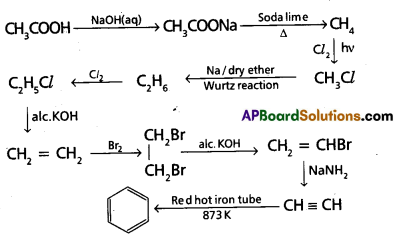Andhra Pradesh BIEAP AP Inter 1st Year Chemistry Study Material 13th Lesson Organic Chemistry-Some Basic Principles and Techniques Textbook Questions and Answers.
AP Inter 1st Year Chemistry Study Material 13th Lesson Organic Chemistry-Some Basic Principles and Techniques
Very Short Answer Questions
Question 1.
Write the reagents required for the conversion of benzene to methyl benzene.
Answer:
Benzene reacts with methyl chloride in presence of anhydrous AlCl3 to form methyl benzene.

This reaction is called as Friedal craft’s alkylation.
Question 2.
How is nitrobenzene prepared.
Answer:
Benzene undergoes nitration with nitration mixture (cone. HNO3 + Cone H2SO4) at less than 60° C to form nitrobenzene.

![]()
Question 3.
Write the conformations of ethane.
Answer:

Question 4.
How do you prepare ethyl chloride from ethylene?
Answer:
Ethylene reacts with hydrogen chloride to form Ethyl chloride in presence of anhydrous AlCl3 catalyst.
![]()
Question 5.
Write the IUPAC names of :
a) CH3 – CH2 – CH2 – CH = CH3
b) 
c) 
Answer:
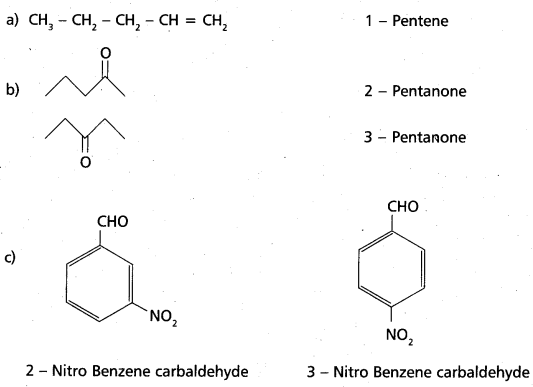
Question 6.
Write the structures of Trichloroethanoic acid, Neopentane, P – nitro benzaldehyde. [Mar. ’13]
Answer:
Trichloro ethanoic acid – CCl3 – COOH

Question 7.
Discuss Lassaigne’s test.
Answer:
Lassaigne’s Test: –
- A small dry sodium piece is taken in a fusion tube and heated gently till the sodium melts.
- To this molten sodium a small amount of organic compound is added and heated until it changes red hot.
- This red hot tube is plunged in a china dish containing water and this content is boiled, cooled and filtered.
- The obtained filtrate is known as Lassaigne’s extract.
- This test is used to detect the elements Nitrogen, Sulphur, halogens etc.,
Detection of Nitrogen : –
The Lassaigne’s extract is made alkaline by adding few drops of dil. NaOH. to this freshly prepared FeSO4 solution is added and warmed then few drops of FeCl3 are added followed by acidification with Cone. HQ (or) H2SO4. A bluish green colouration indicates the nitrogen.
Na + C + N → NaCN
2NaCN + FeSO4 → Na2SO4 + Fe (CN)2
Fe(CN)2 + 4NaCN → Na4 [Fe(CN)6]
3Na4 [Fe(CN)6] 4- 4FeCl3 → Fe4 [Fe(CN)6]3 + 12 NaCl (Prussian blue colouration)
![]()
Question 8.
Explain the principle of chromatography.
Answer:
Chromatography has been developed as a method of separation components of a mixture generally between the stationary phase and a mobile phase.
Chromatography involves the three steps given below :
a) Adsorption and retention of a mixture of substances on the stationary phase and separation of adsorbed substances by the mobile phase to different distances on the stationary phase.
b) Recovery of the substances separated by a continuous flow of the mobile phase (known as elution) and
c) Qualitative and quantitative analysis of the eluted substances.
Question 9.
Explain why an organic liquid vaporizes at a temperature below it’s boiling point in it’s steam distillation.
Answer:
In steam distillation, the liquid boils when the sum of vapour pressures due to the organic liquid (P1) and that due to water (P2) becomes equal to the atmospheric pressure (P) i.e., P = P1 + P2.
∴ P1 is lower than P the organic liquid vaporises at lower temperature than it’s boiling point.
Question 10.
Explain the following :
a) Crystallisation
b) Distillation
Answer:
a) Crystallisation:
- This technique is used for the purification of solid organic compounds.
- This method is based on the difference in the solubilities of the compound and the impurities in a suitable solvent.
- The impure compound is dissolved in a solvent in which it is partially soluble at room temperature and appreciably soluble at higher temperature.
- The solution is concentrated to get a nearly saturated solution on cooling the solution pure compound crystallises.
- On repeating this process finally gets the very pure compound.
b) Distillation :
This method is used to separate
-
- Volatile liquids from non volatile impurities and
- The liquids having enough difference in their boiling points.
- Liquids having different boiling points vapourises at different temperatures.
- These vapours are cooled and the liquids formed are collected separately.
Eg : CHCl3 (b.pt. 334 K) and C6H5NH2 (b.pt. 457 K) are easily separated by distillation technique.
Short Answer Questions
Question 1.
Complete the following reaction and name the products A, B and C. [T.S. Mar. ’15] [A.P. Mar. 16]
![]()
Answer:
CaC2 + 2H2O → Ca(OH)2 + C2H2
Acetylene (= A)

A = C2H2 (Acetylene)
B = C6H6 (Benzene)
C = C6H5CH3 (Methyl benzene)
Question 2.
Name the products A, B and C formed in the following reactions. Give the equations for the reactions.
![]()
Answer:

A = 1, 2- dibromo ethane
B = Acetylene
C = 1, 1, 2, 2 – tetra bromo ethane
![]()
Question 3.
How does acetylene react with : a) Bromine b) Hydrogen ? Write the balanced equations for the above reactions. Name the products.
Answer:
a) Addition of Br2: Acetylene reacts with bromine to form finally 1, 1, 2, 2 – tetra bromo ethane.

b) Addition of hydrogen : Acetylene undergoes addition reaction with hydrogen in the presence of Ni catalyst and gives ethylene and ethane.
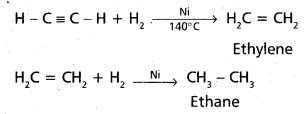
Question 4.
What is substitution reaction ? Explain any two substitutuin reactions of benzene.
Answer:
Substitution : When an atom or a group in molecule is substituted by another atom or group then the reaction is called electrophillic substitution reaction.
e.g. : 1) Friedal craft’s alkylation : C6H6 reacts with chlorine in the presence of AlCl3 and form chloro benzene.
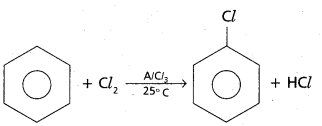
e.g. : 2) Nitration : C6H6 when heated with a mixture of cone. HNO3 and cone. H2SO4, below 60° C, to give nitrobenzene.
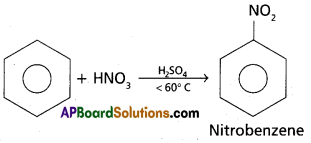
Question 5.
What is dehydrohalogenation ? Write the equation for the formation of alkene from alkyl halide.
Answer:
Removal of hydrogen and halogen from the adjacent carbon atoms is called dehydrohalogenation.
Alkene from alkyl halide : When ethyl chloride is heated with alcoholic KOH, ethylene is formed due to dehydrohalogenation

Question 6.
Which type of compounds react with Ozone ? Explain with one example.
Answer:
1) Unsaturated hydrocarbons react with ozone and form addition compound called ozonide. On hydrolysis the ozonide gives carbonyl compound. This is called ozonolysis.
2) Unsaturated hydrocarbons usually react with ozone. Ozonolysis is used for the location of the double bond in unsaturated compounds like alkene, alkyne and benzene.
Example : Ethylene undergoes addition reaction with ozone and form ozonide. If, on hydrolysis, in presence of Zn dust, gives formaldehyde and H2O2.

![]()
Question 7.
Give two examples each for position and functional isomerism. [A.P. Mar. ’16] [Mar. ’13]
Answer:
Position isomerism : This type of isomerism arises due to the difference in the position of substituent group or in the position of multiple bond.
e.g.:

e.g.: 2. CH3 – CH2 – C = CH 1 – butyne
CH3 – C = C – CH3 2 – butyne
Functional group isomerism : This type of isomerism arises in carbon compounds having the same molecular formula but with different functional groups.
e.g.: 1. CH3 – CH2 – CH2 – OH 1 – proparal (C3H3O)
CH3 – CH2 – O – CH3 methoxy ethane (C3H8O)
e.g.: 2. CH3 – CH2 – OH Ethanol
CH3 – O – CH3 methoxy methane
Question 8.
Explain the mechanism of halogenations of methane.
Answer:
Methane undergoes halogenation (with Cl2) to form finally tetrachloro methane. This is a substitution reaction and takes place in presence of light.

Mechanism:
Halogenation process involves the free radical chain mechanism
This mechanism involves 3 steps
i) Initiation
ii) Propagation
iii) Termination
i) Initiation : The reaction initiated by the cleavage of chlorine molecule in presence of light. Cl – Cl bond is weaker than the C – C and C – H bonds

ii) Propagation : Chlorine free radical attacks the CH4 molecule and generates methyl free radical.
![]()
The methyl radical formed attacks the 2nd molecule of chlorine to form another chlorine free radical.
![]()
Propagation takes place in several steps as follows.

iii) Termination : The reaction terminated after sometime due to consumption of reactants. The following are the possible chain terminating steps

Question 9.
How is ethylene prepared from ethyl alcohol ? Write the equation.
Answer:
Ethylalcohol reacts with Conc.H2SO4 at 170°C to form Ethylene.

The above reaction is dehydration reaction. (H2O removal takes place)
![]()
Question 10.
Explain the reactions of acetylene with : a) Na in NH3 b) chromic acid. Write the equations and name the products.
Answer:
a) With Na in NH3 : Acetylene reacts with Na in liquid NH3 to give monosodium acetylide and disodium acetylide.


b) Chromic acid : Acetylene is oxidised to acetic acid by chromic acid.

Question 11.
Explain crystallisation and sublimation phenomenon which are used in the purification of organic compounds.
Answer:
Crystallisation: The principle used here is that the impurities are insoluble or soluble in the given solvent at any temperature, but the substance to be purified is sparingly soluble at room temperature but highly soluble at highest temp. (i.e.,) almost near the boiling temp. of the solvent.
This method is useful to purify solid compounds.
Sublimation : Some solid substances when heated pass directly into vapour state without melting. Those vapour on cooling form directly solid with out condensing to liquid. This phenomenon is called sublimation.
Impure compound is taken in a beaker covered with a watch glass and heated on an electric plate. The compound sublimates and solidifies on the lower surface of the watch glass. Impurities settle in the beaker. Pure compounds in separated by scratching the watch glass.
This is also a purification method of solids.
Question 12.
Describe solvent extraction method to purify a compound.
Answer:
Solvent extractiân : Suppose an organic compound ‘A’ is more soluble in an organic solvent that in water but present in aq. solution. The aq. solution is shoken with the organic solvent. ‘A’ goes into the organic solvent which is immiscible with water. The organic layer is separated and distilled to remove the liquid solvent. The compound remains with distillation flask.
Question 13.
Explain the estimation of phosphorus and sulphur in the given organic compounds.
Answer:
Estimation of phosphorus : Known mass of organic compound (‘a’ gm) is heated with fuming HNO3 in a carius tube. ‘P’ is oxidised to H3PO4 acid. This acid is precipitated as ammonium phosphomolybdate (‘b’ gm) by adding ammonia and ammonium molybdate solutions.
% g of phosphorus = \(\frac{100}{a}\) × \(\frac{b}{1877}\) × 31 gm
Molecular mass of (NH4)3 PO4. 12 MO O3 (ammonium phosphomolybdate) = 1877
Estimation of sulphur : Known mass of organic compound (‘a’ gm) is heated with sodium peroxide in a carius tube. If sulphur is present it is oxidised to sulphuric acid. The acid is precipitated as barium sulphate (big) by adding excess of aq. BaCl2 solution. The ppt. is filtered, washed, dried and weighed.
% g of sulphur = \(\frac{100}{a}\) × \(\frac{b \times 32}{233}\) g
Molecular mass of BaSO4 = 233
![]()
Question 14.
Explain addition of HBr to propene with the ionic mechanism.
Answer:

Electrophilic addition mechanism : (Ionic Mechanism)
Step (i) ; Formation of carbonium ion

Step (ii) : Stable carbonium ion is attacked by Br⊖

Question 15.
What is the product formed when sodium propionoate is heated with soda lime, (imp)
Answer:
Sodium propionate is heated with sodalime to form ethane. This reaction is decarboxylation reaction. NaOH + CaO is called as Decarboxylating agent.

Long Answer Questions
Question 1.
Explain the classification of hydrocarbons.
Answer:
Classification of hydrocarbons : Hydrocarbons are classified as aliphatic hydrocarbons and aromatic hydrocarbons. Aliphatic hydrocarbons are again classified as open chain hydrocarbons and closed chain hydrocarbons i.e., cyclohydrocarbons. Both open chain and closed chain hydrocarbons are again classified as hydrocarbons containing C – C single bonds. > C = C < compounds, – C = C – hydrocarbons. Aromatic compounds are called benzenoids as they are related to benzene.
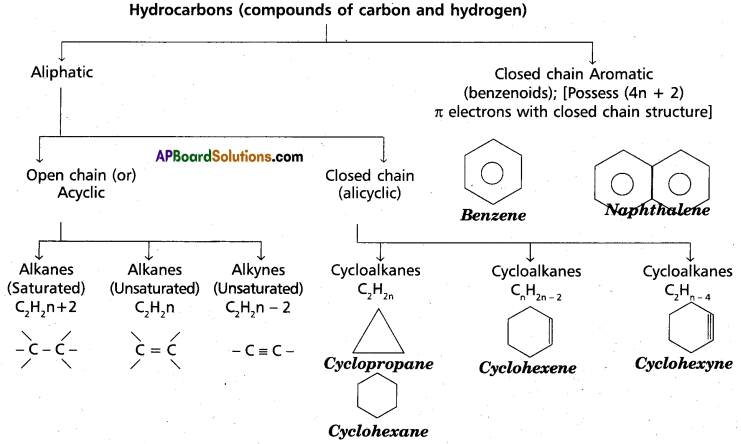
Question 2.
Write IUPAC names of the following compounds :
a) ![]()
b) CH2 = CH – C C – CH3
c) CH3 – CH = C (CH3)2
d) ![]() CH2 – CH2 – CH = CH2
CH2 – CH2 – CH = CH2
e)

Answer:
a) 1, 3 – Buta diene
b) CH2 = CH – C ≡ C – CH3
Pent, 1 -ene 3 – yne
c) CH3 – CH = C (CH3)2
2 – Methyl 2 – Butene
d) 
e)

4 – ethyl Dec 1, 5, 8 – Triene
![]()
Question 3.
Describe two methods of preparation of ethane. Give any three reactions of ethane.
Answer:
Methods of preparation of ethane:
1. Decarboxylation:
Ethane is prepared by heating sodium propionate with sodalime.

2. Kolbe’s electrolysis:
Ethane is obtained by the electrolysis of potassium acetate solution.

H2 gas evolves at cathode.
Ethane and CO2 are formed at anode.
Chemical properties of ethane :
1. Halogenation:
Ethane reacts with chlorine in the presence of sunlight. Hydrogen atoms are substituted by halogen atoms successively. The final product is Hexachloro ethane.

2. Nitration:
Ethane reacts with nitric acid at 400° C and gives nitro ethane.

3. Pyrolysis:
When ethane is heated in the absence of oxygen it decomposes giving ethylene and hydrogen.
![]()
Question 4.
Write the structural formulas and IUPAC names for all possible isomers having the number of double (or) triple bond as indicated :
a) C4H8 (one double bond)
b) C5H8 (one triple bond)
c) C5H12 (No multiple bonds).
Answer:
a) The possible Isomers of C4H8 (one double bond)

b) The possible Isomers of C5H8 (one triple bond)

c) The possible Isomers of C5H12 (No multiple bonds)
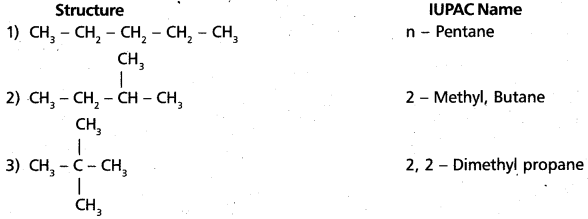
Question 5.
Write chemical equations for combustion reaction of the following hydrocarbons.
a) Butane
b) Pentene
c) Hexyne.
Answer:
a) Combustion of Butane :
C4H10 + \(\frac{13}{2}\) O2 → 4CO2 + 5H2O + Energy
b) Combustion of Pentene:
C5H10 + \(\frac{15}{2}\) O2 → 5CO2 + 5H2O + Energy
c) Combustion of Hexyne:
C6H10 + \(\frac{17}{2}\) O2 → 6CO2 + 5H2O + Energy
![]()
Question 6.
Addition HBr to propene yields 2 – bromopropane, while in the presence of benzoyl peroxide, the same reaction yields 1 – bromo propane. Explain and give mechanism.
Answer:
- Addition of HBr to propene yields 2 – Bromopropene. Here the reaction mechanism is electrophillic. addition mechanism.
- Addition of HBr to propene in presence of benzoyl peroxide the reaction proceeds through free radical mechanism.

Electrophilic addition mechanism : (Ionic Mechanism)
Step (i) : Formation of carbonium ion
HBr → H+ + Br⊖
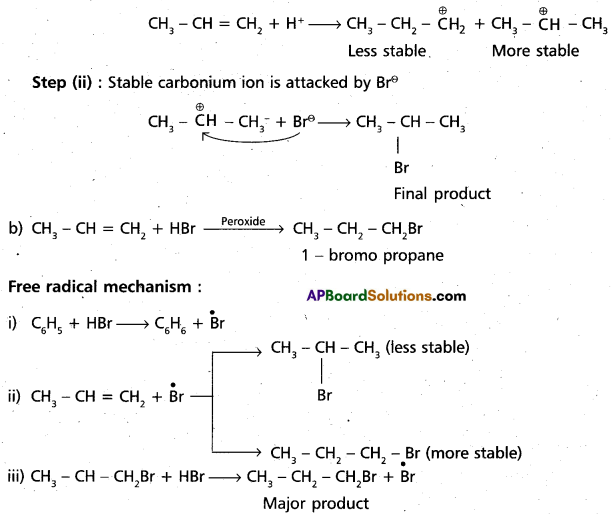
Question 7.
Describe two methods of preparation of ethylene. Give equation for the reactions of ethylene with the following,
a) Ozone
b) Hypohalous acid
c) Cold and dil. alkKMno4
d) Heated with O2 at high pressure
Answer:
Preparation of ethylene:
1. Dehydrohalogenation of alkyl halide: When ethylbromide is heated with alcoholic KOH, ethylene is formed.

2. Dehydration of ethanol: When ethanol is heated with cone. H2SO4 at 170°C, ethylene is obtained.
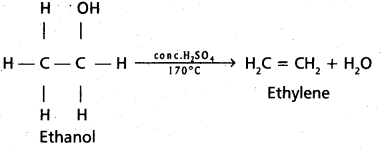
Chemical properties :
a) With O3: Ethylene undergoes addition reaction with ozone and gives a cyclic compound called ozonide. It undergoes hydrolysis in the presence of zinc dust to give formaldehyde.

b) With HOCl : Ethylene reacts with hypochlorous acid and gives ethylene chlorohydrin.

c) Cold and dil. alk. KMnO4: Pink coloured cold and dil. alkaline KMn04 solution is Bayer’s reagent. Ethylene decolourises Bayers reagent to give ethylene glycol. This is test for unsaturation.

d) Polymerisation : When Ethylene is heated in the presence of 02 at a temperature of 200° C and high pressure of 1500 – 2000 atmospheres gives polyethene.

![]()
Question 8.
How does ethylene react with the following reagents ? Give the chemical equations and names of the products formed in the reactions,
a) Hydrogen halide
b) Hydrogen
c) Bromine
d) Water
e) Oxygen in presence of Ag at 200° C.
Answer:
(a) Reaction with hydrogen halide : Ethylene reacts with Hydrogen halides to give ethyl halides.
H2C = CH2 + HX → CH3 – CH2 X
e.g.: H2C – CH2 + HCl → C2H5Cl Ethyl chloride
(b) With Hydrogen : Ethylene reacts with H2 in presence of Ni, Pt or Pd to give ethane.

(c) With Bromine : Ethylene decolourises red coloured Br2 in CCl4 to give 1,2- dibromo ethane.

(d) With water : Ethylene reacts with dil. H2SO4 to give ethyl alcohol.

(e)With Sulphur monochloride : Ethylene reacts with S2Cl2 to give musturd gas.

(f) With O2 at presence of Ag: Air oxidises ethylene to ethylene oxide known as epoxide in presence of Ag catalyst at 200 – 400°C.

Question 9.
An alkene ‘A’ on ozonolysis gives a mixture of ethanal and pentan 3-one. Write the reaction, structure of the products and alkene – A. Give the IUPAC name of alkene – A.
Answer:

Question 10.
An alkene ‘A1 contains three C – C, eight C – H bonds and one C = C bond. ‘A’ on ozonolysis gives two moles of an aldehyde of molar mass 44o . Write IUPAC name of ‘A’.
Answer:

IUPAC name of ‘A’ is 2 – Butene
![]()
Question 11.
Give two methods of preparation of acetylene. How does it react with water and Ozone ?
Answer:
Preparation of acetylene :
1. Dehydrohalogenation : Acetylene is obtained when dibromo ethane is heated with alcoholic KOH.

2. Acetylene is obtained by heating iodoform with silver powder.
![]()
3. Addition of water : Acetylene undergoes addition reaction with water in the presence of mercuric sulphate and sulphuric acid. Vinyl alcohol formed in the reaction undergoes rearrangement and gives acetaldehyde . [Mar. 06, June 04]

4. Reaction with ozone : Acetylene reacts with ozone to form an ozonide which on hydrolysis in presence of Zn forms glyoxal. [June 04]

Question 12.
How does acetylene react with the following reagents ? Give the corresponding equations and name the products formed in the reactions
a) Acetic acid
b) Water
c) Hydrogen
d) Halogens
e) Hydrogen halide
f) Ammonical AgNO3 and Cl2Cl2 [T.S. Mar. 16]
Answer:
(a) Reaction with Acetic acid : Acetylene on treatment with acetic acid gives vinyl acetate in the 1st step and then gives ethylidene acetate. Hg2+ ions act as catalyst.

(b) Addition of water: Acetylene undergoes addition reaction with water in the presence of mercuric sulphate and sulphuric acid. Vinyl alcohol formed in the reaction undergoes rearrangement gives acetaldehyde.

(c) Addition of hydrogen : Acetylene undergoes addition reaction with hydrogen in the presence of Ni catalyst and gives ethylene and ethane.

(d) Addition of halogens : Acetylene undergoes addition reaction with halogens to give 1, 1, 2, 2 tetra haloethane. Dihalo alkene is formed in the first step which then adds on another molecule of halogen to give tetra halo ethane.

(e) With Hydrogen halide : Acetylene on addition with HCl gives Vinyl chloride and finally 1, 1 – dichloroethane.

(f) With Ammonical AgNO3 solution : Acetylene gas is passed through ammonical AgNO3 solution to form a white precipitate of silver acetylide. .

With Ammonical Cu2Cl2 solution : Acetylene gas is passed through Ammonical cuprous chloride solution to give a red precipitate of cuprous acetylide.

![]()
Question 13.
Describe any two methods of preparation of benzene with corresponding equations. Benzene does not behave like an alkenes why ? How do we get methyl benzene from benzene ?
Answer:
Preparation of Benzene:
1. When sodium benzoate distilled with sodalime. Benzene is formed.

2. Polymerisation of Acetylene : When Acetylene gas is passed through red hot Cu or Fe tubes, it polymerises and gives Benzene.
![]()
Constitution of Benzene : Benzene molecule cannot be represented by a single structure. It has the following Resonance structures.

The resonance energy of Benzene is 150.48 KJ/mole. Thus, it has more stability. Hence does not undergo addition reactions like alkenes. Benzene is an aromatic molecule.
Benzene to toluene (Friedal Craft’s Alkylation) :
Benzene reacts with methyl chloride in presence of AlCl3 and forms methyl benzene (Toluene).

Question 14.
How do we get benzene from acetylene ? Give the corresponding equation. Explain the halogenations, alkylation, acylation, nitration and Sulphonation of benzene.
Answer:
Preparation of Benzene from acetylene: On passing acetylene gas through red hot iron tubes, it trimerises to give benzene.

Chemical Properties:
(1) Halogenation : Benzene reacts with chlorine in the presence of FeCl3 or AlCl3 to give chioro-benzene.

(2) Friedel – Craft’s Alkylation : Benzene reacts with alkyl halides in the presence of AlCl3 to give alkyl benzene.
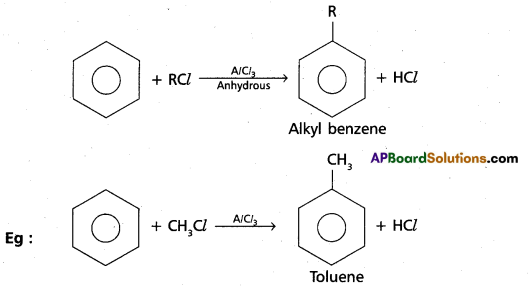
(3) Friedel – Craft’s Acylation : Benzene reacts with acetyl chloride in the presence of AlCl3 to give acetophenone.

(4) Nitration : Benzene when heated with a mixture of cone. H2SO4 and cone. HNO3 below 60°C to give Nitrobenzene.
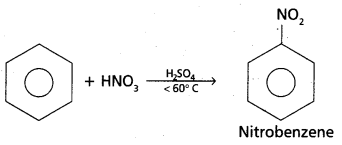
(5) Sulphonation : With fuming H2SO4, benzene, reacts to form benzene sulphonic acid.

![]()
Question 15.
Explain the differences between structural isomers and stereo isomers.
Answer:
Structural isomerism : When the isomerism is due to difference in the arrangement of atoms within the molecule, without any reference to space, the phenomenon is known as Structural isomerism. In this type of isomerism, the isomers possess the same molecular formula, but different structural formula.
Structural isomerism is further classified into different types :

Stereoisomerism : The stereoisomers have the same molecular and structural formula, but differ in the arrangement of atoms or groups in space. Thus the phenomenon exhibited by two or more compounds with the same molecular and structural formulae, but different spatial arrangement of atoms or groups. The spatial arrangement of atoms or groups is also referred to as configuration of the molecule. It is further classified into three types.

Question 16.
What is the differences between conformation and configuration in open chain molecules.
Answer:
Configurational Isomerism : (Optical and geometrical isomerism): These are the stereo – isomers which are discrete, stable and isolable substances. They cannot be inter-converted into one another without making and breaking of new bonds. These isomers cannot be superimposed on each other.
These isomers are further classified as enantiomers, diastereomers and geometrical isomers.
Conformational Isomers : These are the stereo – isomers that easily convert into one another by the rotation around “C – C” bonds. These are in dynamic equilibrium with one another and cannot be separated under ordinary conditions.
This type of isomerism is in alkanes such as n – butane.
Question 17.
What do you understand about geometrical isomerism ? Explain the geometrical isomers of 2 – butene.
Answer:
Geometrical isomerism (Cis – trans isomerism): The isomers which possess the same structural formula but differ in spatial arrangement of the groups around the double bond are called geometrical isomers and the phenomenon is known as geometrical isomerism.
When the same groups lie on the same side of double bond, it is Cis – isomer, while when the same groups lie on opposite side of double bond, the isomer is trans.

![]()
Question 18.
Explain the method of writing E – Z configurations for geometrical isomers taking CHCl = CFBr as your example.
Answer:
E – Z configurations for geometrical isomers : The following procedure is followed in specifying the configurations of compounds.
i) Arrange the atoms / groups attached to each doubly bonded carbon in the order of their atomic numbers.
ii) Choose the atom/group higher priority on each doubly bonded carbon. If the atoms/groups of higher priority on each carbon are on the same side of the molecule, the letter “Z” is used to denote the configuration of such isomer. When the atoms/groups of higher priority on each carbon are on the opposite sides of the molecule, the letter ‘E’ is prefixed before the name to indicate configuration.
Example : CHCl = CFBr
Among H and Cl, 17Cl gets more priority than 1H
Among H and Br, 35Br gets more priority than 9F

Question 19.
If an alkene contains on carbons at double bond Cl. Br and – CH2 – CH2 – OH – CH (CH3)2, Write the E and Z configurations of it.
Answer:
From the given data, the structural formulae of the molecule is

Question 20.
Write a note on :
a) Distillation
b) Fractional distillation
c) Distillation under reduced pressure
d) Steam distillation.
Answer:
a) Distillation : This process is useful for the purification of liquids contaminated with nonvolatile impurities. The impure liquid is boiled in a distillation flask and the vapours are condensed and collected in a receiver. This method can also be used to separate liquids if only their boiling points differ by above 40°C. However, in the case of liquids that have boiling point difference less than 40°C fractional distillation method is used.
b) Fractional distillation : Fractional distillation for liquids that have B.Pt difference less than 40°C. The technique here is that vapours of liquid mixture. When pass through long fractionating column vapours of the liquid with high B.Pt condense and those with low B.Pt pass over through the condenser get condensed and collected in the receiver.
Here, long tubes having different shapes and designs to fit for particular requirements are used.
These are called fractionating columns. The liquid mixture is taken in a distillation flask i.e., fitted with a fractionating column at its mouth. At the upper end of the column, there is a provision to connect it to the water condenser.
c) Distillation under reduced pressure : This method is useful to purify liquids that have very high boiling points and those which decompose at or below their boiling points. If the external pressure is reduced the liquid boils at lower temperature than its normal boiling point without decomposition.
d) Steam distillation : Here liquids which are immiscrible in water passes high boiling point and steam volatile are purified. In this method steam is passed into the hot liquid that is to be purified. The mixture of steam and vapour of volatile organic compound come out. This is because of the sum of the vapour pressures of steam and the liquid to be purified become equal to the atmospheric pressure. They are passed through the condenser and condensed and finally collected in the receiver. The water layer and the organic liquid layer are separated using a separating funnel.
Question 21.
Write a brief note on chromatography.
Explain the following :
a) Column chromatography
b) Thin layer chromatography
c) Partion chromatography.
Answer:
Chromatography has been developed as a method of separation components of a mixture generally between the stationary phase and a mobile phase.
Chromatography involves the three steps given below :
a) Adsorption and retention of a mixture of substances on the stationary phase and separation of adsorbed substances by the mobile phase to different distances on the stationary phase.
b) Recovery of the substances separated by a continuous flow of the mobile phase (known as elution) and
c) Qualitative and quantitative analysis of the eluted substances.
Classification :
Two general chromatography techniques are discussed below. They are :
- adsorption chromatography
- partition chromatography.
Adsorption chromatography is based on the adsorption of different compounds on an adsorbent to different degrees. Generally used adsorbents are silica gel and alumina. A mobile phase is allowed to move over a stationary phase, the adsorbent. The components of the mixture move to different distances over the stationary phase.
Differential adsorption principle is used in
a) column chromatography and
b) thin layer chromatography.
Column chromatography : In the column chromatography the components of a mixture are separated by a column of adsorbent packed in a glass tube. The column is fitted with a stopcock at its lower end. The mixture to be adsorbed on the adsorbent is placed at the top of the stationary phase. A suitable eluant, either a single solvent or a mixture of solvents is allowed to flow down the column slowly. Depending on the degree to which the compounds are adsorbed the components are separated. The most readily absorbed substances are retained near the top and other come down accordingly to various distances.
Thin layer chromatography (TLC): This also involves adsorption differences. Here the adsorbent, say silica gel or alumina is coated over a glass plate of suitable size in thin layer. The plate is called TLC plate or chromoplate. The solution of the mixture to be separated is applied as a small spot at about 2 cm from the bottom of the plate. The plate is then kept in a closed jar containing the eluant. As the eluant rises up the plate, the components of the mixture move up along with the eluant to various distances depending on their degree of adsorption.
The relative adsorption of a component of the mixture is expressed in terms of its RETARDATION FACTOR (Rf) value.
Rf = \(\frac{\text { Distance moved by the subs tance from base line }(\mathrm{X})}{\text { Dis tance moved by the solvent from base line }(\mathrm{Y})}\)
Partition chromatography : This is based on continuous differential partitioning of components of a mixture between the Stationary phase and the mobile phase. In paper chromatography, for example, a special paper called chromatography paper contains water trapped in it which acts as the stationary phase. The chromatography paper spotted with the solution of the mixture at the base is suspended in a suitable solvent or a mixture of solvents.
This solvent acts as the mobile phase. The solvent rises up the paper by capillary action and moves over the spot. The paper selectively retains different components as per their differing partition in mobile and stationary phase. The paper strip so developed is known as chromatogram. The spots of the separated coloured compounds are detected and for colourless compounds other methods like spraying suitable reagent, are used.
![]()
Question 22.
Explain the estimation of nitrogen of an organic compound by
a) Duma’s method
b) Kjeldahl’s method.
(or)
Describe Duma’s and Kjeldahl’s method for the estimation of Nitrogen.
Answer:
Estimation of nitrogen : There are two methods to estimate nitrogen in the given organic compound known as
i) Duma’s method and
ii) Kjeldahed’s method.
i) Duma’s method : In this method a known weight of organic compound is heated strongly with coarse cupric oxide. Carbon and hydrogen get oxidised to carbon dioxide and water vapour respectively. Nitrogen if present is converted to nitrogen gas. Even if some nitrogen is converted to its oxides. They are reduced by hot copper gauze to nitrogen. The product gases are collected over a solution of potassium hydroxide. CO2 is absorbed by KOH solution. Nitrogen is collected over potassium hydroxide solution and its volume is found out.

Suppose that ‘a’ g of organic compound gives V1 ml of N2 at room temperature TK. If atmosphere pressure is P and aqueous tension at TK is P, then the pressure of nitrogen gas at TK is (P – p). Let (P – p) = P1 Reduce the volume of nitrogen to standard temperature 273 K and standard pressure 760 mm.
Volume of nitrogen at STP is v = \(\frac{\mathrm{P}_1 \mathrm{~V}_1}{\mathrm{~T}_1} \times \frac{273}{760}\)
28 g of nitrogen at STP occupies 22400 ml
? g. of nitrogen at STP occupies Vml. of nitrogen.
28 × \(\frac{V}{22400}\)g
‘a’ g. of organic compound \(\frac{28 \times V}{22400}\) g of nitrogen.
100 g organic compound has ? of nitrogen = \(\frac{100}{a} \times \frac{28 \times V}{22400}\) g
ii) Kjeldah’s method : This is another method to estimate nitrogen. In this method, the compound is heated with concentrated sulphuric acid in the presence of small amount of CuSO4.
Nitrogen is quantitatively converted into ammonium sulphate. The contents of the flask are transferred to another flask and heated with excess of sodium hydroxide solution to liberate ammonia gas. Ammonia gas so liberated is passed and absorbed in a known volume of known concentrated sulphuric acid that is relatively more in amount than that is required to neutralise NH3 gas. Now, the excess of acid remained after the neutralisation by NH3 is titrated against a standard solution of alkali. From the above, the amount of H2SO4 used to neutralise NH3 is calculated. From this, the mass of ammonia formed is calculated and from that percentage of nitrogen is calculated.
Organic compound + H2SO4 →(NH4)2 SO4
(NH4)2SO4 + 2 NaOH → Na2SO4 + 2 H2O + 2 NH3
2 NH3 + H2SO4 → (NH4)2SO4
Calculation :
Let the mass of organic compound taken be ‘a’ g.
Let the volume of H2SO4 initially taken be ‘Vml‘ and its molarity M.
After passing the NH3 gas into the above acid, if the remaining acid is titrated with M molar NaOH and it consumes V1 ml. of NaOH for complete neutralisation, then from the formula
\(\frac{\mathrm{MV}_1}{\mathrm{n}_1}\) (NaOH) = \(\frac{\mathrm{MV}_2}{\mathrm{n}_2}\) (H2SO4)
From the stoichiometric equation
2 NaOH + H2SO4 → Na2SO4 + 2H2O
n1 = number of moles of NaOH = 2; n2 = number of moles of H2SO4 = 1
\(\frac{\mathrm{MV}_1}{2}\) = \(\frac{\mathrm{MV}_2}{1}\) or V2 = \(\frac{\mathrm{V}_1}{2}\) ml
Therefore, the volume of H2SO4 neutralised by NH3 is [V – \(\frac{\mathrm{V}_1}{2}\)] ml
(or) it is equal to 2 [V – \(\frac{\mathrm{V}_1}{2}\)] ml. of M molar NH3 solution.
1000 ml. of 1M NH3 solution contains 17g. of NH3 or 14g. of N2
2[V – \(\frac{\mathrm{V}_1}{2}\)] ml ml. of ‘M’ NH3 solution contains
\(\frac{14 \times M \times 2\left[V-\frac{V_1}{2}\right]}{1000}\) g. of nitrogen.
Percentage of nitrogen = \(\frac{14 \times M \times 2\left[V-\frac{V_1}{2}\right]}{1000} \times \frac{100}{a}\)
![]()
Question 23.
Explain inductive effect with a suitable example.
Answer:
Inductive effect: The electron donating or electron with drawing effect of a groups an atom that is transmitted by the polarisation of electrons in σ bonds is called inductive effect.
Illustration : Consider the molecule CH3 – CH2 – CH2 – Cl. There is a ‘σ’ covalent bond between carbon atom and chlorine atom. The electron pair between them is not equally shared. The more electronegative chlorine atom tends to attract the shared pair more towards itself. Due to this, the electron density tends to be greater nearer chlorine atom than carbon atom. It is generally represented
as ![]() But, carbon atom bonded to chlorine atom is itself attached to other carbon atoms. Therefore, the effect can be transitted further
But, carbon atom bonded to chlorine atom is itself attached to other carbon atoms. Therefore, the effect can be transitted further ![]()
“Inductive effect is defined as the polarisation of a bond caused by the polarization of adjacent σ bond”.
(-I) effect i.e., electron with drawing effect is in the order
+NH3 > NO2 > CN > SO3H > CHO > CO > COOH > COCl > COOR > CONH2 > F > G > Br > I > OH > OR > NH2 > C6H5 > H.
+ I effect is – \(\bar{N} R\) > – \(\overline{O}\) ; – Se > S > -O ; – C(CH3)3 > – CH(CH3)2 > – CH2CH3 > – CH3.
Question 24.
Write a note on mesomeric effect.
Answer:
Mesomeric effect:
“The electron pair displacement caused by an atom or group along a chain by a conjugative mechanism is called the mesomeric effect of that atom or group”.
Salient features of the mesomeric effect:
i) Permanent effect operating in the ground state of the molecule.
ii) Lone pairs and n electrons are involved and operate through conjugative mechanism of electron displacement.
iii) It influences the physical properties, reaction rates etc.
Groups which tend to increase the electron density of the rest of the molecule are said to have (+M) effect. Such groups tend to posses lone pairs of electrons.
e.g. : ![]()
Groups that decrease the electron density of the rest of the molecule are said to have (-M) effect. Unsaturated groups having polar character have – M effect.
![]() . Here C = O group decreases the electron density of the remaining molecule. It has – M effect.
. Here C = O group decreases the electron density of the remaining molecule. It has – M effect.
+ M effect is – F > – Cl > – Br > – I;
-NR2 > OR > F;
– NH2 > – OH > – F;
– OR > – SR > SeR
– O > – OR
– M effect is = O > = NR > = CR2
= NR2< =NR ≡ N > ≡ CR
Question 25.
Describe resonance effect with one example.
Answer:
Resonance effect: It is the polarity produced in a molecule by the interactions of two n bonds or between a π bond and a lone pair of electrons present on adjacent atoms. This effect is transmitted through the chain.
If the transfer of electron is away from the atoms or substituent group attached to the conjugated system, then the molecule gets some of its positions high electron density as in aniline and it is given (+ R). If the shift of electrons are towards the atom or substituent group it is (- R) as in nitrobenzene.

Groups showing (+ R) are X, – OH, – OR, – COOR, – NH2, – NHR, – NR2, – NHCOR etc.
(- R) effect are – COOH, CHO, > C = O, – CN, – NO2.
![]()
Question 26.
Explain how many types of organic reactions are possible.
Answer:
Organic reactions are mainly classified into four types known as
i) Addition rections.
ii) Substitution reactions
iii) Elimination reactions
iv) Molecular rearrangements.
i) Addition reactions : In these reactions the reagent and the substract combine together to give a single product.
e.g.: 
Depending on the reagent added in the slow rate determining step, addition reactions are again a) Electrophilic classified addition reactions, b) Nucleophilic addition reactions c) Free radical addition reactions.
ii) Substitution reactions : In these reactions on atom or a group of the substrate species is replaced by another atom or group. These are again classified as a) Electrophilic substitution b) Nucleophilic substitution and c) Free radical substitution reactions on the basis of the reagent involved in the rate determining step.
e.g.-: \(\overline{\mathrm{O}}\)H(aq) + R – X → HO – R + X(aq)
iii) Elimination reactions : In these reactions two or more atoms or groups of an organic substrate are removed to form multiple bonds.

iv) Molecular rearrangements : Here one organic species (generally less stable) rearranges to other species (generally more stable). For example. Fries rearrangement.

Question 27.
Write the possible conformations of ethane and explain which is more stable.
Answer:
Conformation of ethane : The conformational isomers of a given alkane are obtained by rotation about C – C bond and they are represented by Newman projections or line – Wedge or Sawhorse projections. Newman projections and energy diagrams for the various conformations of ethane are given below.

Staggered (S) occurs at Dihedral angle 60°, 180°, 300°
Rotation about the carbon – carbon bond in ethane is though very rapid, not completely free. Two conformations of ethane known as staggered conformation (S) and the eclipsed conformation (E) are very important though infinite number of confomation are possible.
The C – H bonds in the staggered conformation are arranged so that each one bisects the angle defined by two C – H bonds on adjacent carbon. In the eclipsed conformation each C – H bond is aligned with a C – H bond on adjacent carbon.
In the staggered one the distance between the hydrogen nuclei is 2.55 A° but in eclipsed 2.29 A°. The staggered and elipsed conformations are interconvertible by rotation of one carbon with respect to the other around the a bond that connects them. Different conformations of the same molecule are also called conformers or rotamers.
Stability :
Staggered (S) form is more stable than eclipsed. Because in case of eclipsed form electronic repulsions are high and in case of staggered form electronic repulsions are minimum.
Question 28.
Explain aromatic electrophillic substitution reactions of benzene.
Answer:
1) Halogenation : Benzene reacts with bromine or chlorine in the presence of Lewis acids like FeCl3, AlCl3 etc., to give corresponding halobenzene.
e.g. :

Similarly with bromine, bromobenzene is formed.
2) Nitration : Benzene undergoes nitration when heated with a mixture of 1 : 1 (by volume) concentrated nitric acid and concentrated sulphuric acid (nitration mixture) at a temperature below 60° C.

3) Benzene reacts with fuming sulphuric acid (oleum) and gives benzene sulphonic acid.
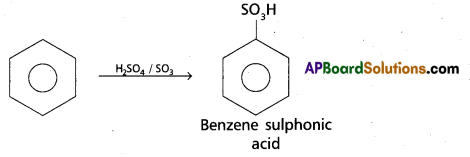
4) Friedel – Craft’s alkylation and acylation : Benzene reacts with alkyl halides and acylh in the presence of Lewis acids (AlCl3, FeCl3) and gives alkyl benzenes and acyl benzenes.

Benzene reacts with acetyl chloride in the presence of anhydrous aluminium, chloride and acetophenone.

General Mechanisms : Electrophilic substitution reaction (SE) proceeds in two steps as
I. Generation of electrophile
II. a) Formation of carbocation intermediate
b) Removal of proton from carbocation intermediate.
I. Generation of electrophile E+: In the reactions halogenation, alkylation and acylatio benzene, anhydrous AlCl3, the Lewis acid produces electrophile X+ say Cl+, R+ and RCO+ by reacting the reagent chlorine, alkyl halide and acylhalide respectively.

II. a) Formation of carbocation : Electrophile generated above attacks one of the benz carbons to change it to sp3 hybridised. The carbocation (Arrhenium ion) is stabilised through resonal.
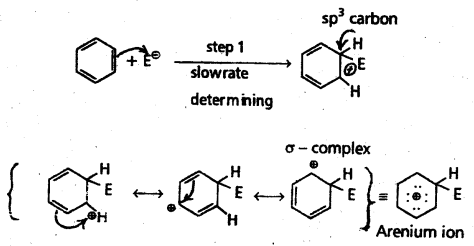
Sigma complex loses aromatic character due to delocalisation of electrons stopping at sp3 carb
![]()
b) Losing of proton : To regain aromatic character the \(\stackrel{+}{\mathrm{C}}\) loses one proton to sp3 carbon on attack
of (AlCl4)– in case of halogenation, alkylation and acylation and HSO4– in case of nitration.

Question 29.
Explain electrophilic addition reactions of ethylene with mechanism.
Answer:
Electrophilic addition reactions of ethylene :
1. Addition of Hydrogen : Ethylene react with hydrozen in the presence of Pt, Pd or Ni catalyst to form ethane.

2. Addition of halogens : Halogens (Cl2 or Br2) react with ethylene in the presence of an inert solvent like CCl4 to form dihalo derivative

Mechanism :

3. Addition of hydrogen halides : Ethylene reacts with HBr to form ethyl bromide
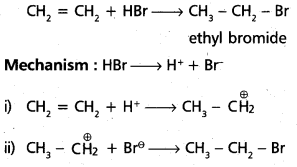
4. Addition of water : In presence of few drops of cone. H2SO4, water adds to ethylene to form alcohol.

Question 30.
With the help of mechanism explain free radical halogenations of alkanes.
Answer:
Methane undergoes halogenation (with Cl2) to form finally tetrachloro methane. This is a substitution reaction and takes place in presence of light.

Mechanism :
- Halogenation process involves the free radical chain mechanism
- This mechanism involves 3 steps
i) Initiation
ii) Propagation
iii) Termination
i) Initiation : The reaction initiated by the cleavage of chlorine molecule in presence of light. Cl – Cl bond is weaker than the C – C and C – H bonds

ii) Propagation : Chlorine free radical attacks the CH4 molecule and generates methyl free radical.
![]()
The methyl radical formed attacks the 2nd molecule of chlorine to form another chlorine free radical.

iii) Termination : The reaction terminated after sometime due to consumption of reactants.
The following are the possible chain terminating steps

![]()
Question 31.
Discuss Markownikov’s rule and Kharash effect.
Answer:
Statement of Markownikoff’s rule : The rule states that when an unsymmetrical reagent adds to a double bond, the positive part of the adding reagent attaches itself to a carbon of the double bond so as to yield the more stable carbocation as an intermediate.
Mechanism : A pair of electrons from the double bond attacks the electrophilic HX to produce an achiral trigonal planar carbocation intermediate. Thehalideion X then adds to either face of the positively charged carbon forming alkyl halide product.

Anti Mark Kownikoffs addition or peroxide effect or Kharasch effect : In the presence of peroxide (R – O – O – R) the addition of HBr to unsymmetrical alkene like propene takes place against Markowni- koff’s rule. As per Anti Markownkoff’s rule, the addition of HBr to an unsymmetrical alkene like propene takes place in such a way that the hydrogen atom becomes attached to the carbon atom with the fewer hydrogen atoms.
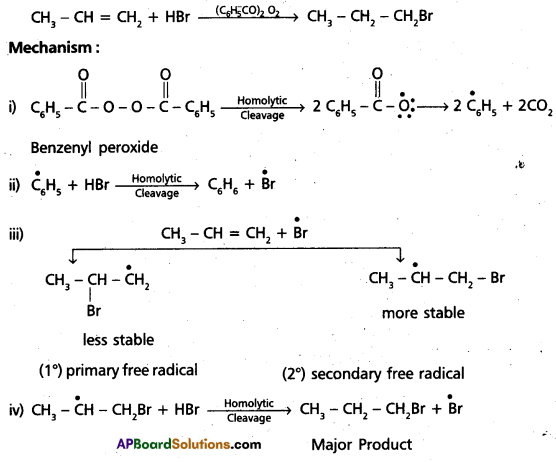

The 2° free radical is more stable than 1°. Therefore. 1 – bromopropane is major product.
Question 32.
How would you convert benzene in to following compounds ?
a) Chioro benzene
b) Toluene
c) p – nitrotoluene.
Answer:
a) Benzene reacts with chlorine inpresence of FeCl3 to form chlorobenzene.
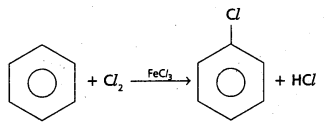
b) Benzene reacts with methyl chloride in presence of AlCl3 to form toluene (Friedal Craft’s alkylation)

c) From benzene p – nitro Toluene is obtained as follows.
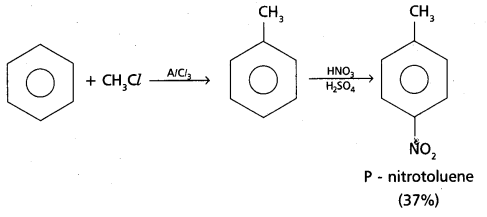
Question 33.
Why is wurtz reaction not preferred for the preparation of alkanes containing odd number of carbon atoms ? Illustrate with one example.
Answer:
Wurtz reaction Alkyl halides reacts with sodium metal in presence of dry ether to form higher alkanes.
R – X + 2Na + R – X ![]() R – R + 2NaX
R – R + 2NaX
- Wurtz reaction is preferred to prepare even no.of Carbons containing alkanes but not for odd no.of Carbons containing Alkanes.
- For getting odd no.of Carbons containing alkanes we have to consider two different alkyl halides.
The products obtained are in mixture form, So the percentage of the desired hydrocarbon is less, i.e., yield of the desired product is low.
Methane can not be prepared by this reaction.
Question 34.
Write the equations involved in the detection of Nitrogen, Halogens and sulphur in organic compounds.
Answer:
Lassaigne’s Test : –
- A small dry sodium piece is taken in a fusion tube and heated gently till the sodium melts.
- To this molten sodium a small amount of organic compound is added and heated until it changes red hot.
- This red hot tube is plunged in a china dish containing water and this content is boiled, cooled and filtered.
- The obtained filtrate is known as Lassaigne’s extract.
- This test is used to detect the elements Nitrogen, Sulphur, halogens etc..
Detection of Nitrogen : –
The Lassaigne’s extract is made alkaline by adding few drops of dol. NaOH. to this freshly prepared FeSO4 solution is added and warmed then few drops of FeCl3 are added followed by acidification with Cone. HCl (or) H2SO4. A bluish green colouration indicates the nitrogen.
Na + C + N →NaCN
2NaCN + FeSO4 → Na2SO4 + Fe (CN)2
Fe(CN)2 + 4NaCN → Na4 [Fe(CN)6]
3Na4 [Fe(CN)6] + 4FeCl3 → Fe4 [Fe(CN)6]3 + 12 NaCl (Prussian blue colouration)
b) Detection of Halogens : The sodium fusion extract is acidified with HNO3 and is treated with AgNO3 solution.
Ag + X → AgX
- White PPt indicates ClΘ ion
- Pale yellow PPt indicates BrΘ ion
- Yellow PPt indicates IΘ ion
c) Detection of Sulphur : To the sodium extract freshly prepared sodium nitroprusside solution. A deep violet colouration takes place.
S-2 + [Fe(CN)5NO]2+ → [Fe(CN)5 NOS]4- Violet
![]()
Question 35.
Explain how carbon and Hydrogen are quantitatively determined in an organic compound.
Answer:
Estimation of carbon and hydrogen : Both the elements are estimated in the same experiment simultaneously. A known weight of the organic substance is taken and completely burnt in excess of air and copper (II) oxide carbon changes to CO2 and Hydrogen to H2O.
CxHy + (x + \(\frac{y}{4}\))O2 → x CO2 + (\(\frac{y}{2}\)) H2O
CO2 and H2O SO obtained are passed through already weighed ‘U‘ – tubes containing anhy, CaCl2 and caustic potash respectively. The increased weigh is of these two tubes give the weigh of H2O formed and weight of CO2 formed.
Suppose ‘a’ g of organic compound on combustion gives ‘b’ grams of water vapour and. ‘C g of CO2. Then
% g of Carbon = \(\frac{12}{44}\) × \(\frac{100}{a}\) × C g
% g of Hydrogen = \(\frac{2}{18}\) × \(\frac{100}{a}\) × b g
Question 36.
How do you determine sulphur, phosphorous and Oxygen are determined quantitatively in an organic compound ?
Answer:
Estimation of phosphorus : Known mass of organic compound (‘a’ gm) is heated with fuming HNO3 in a carius tube. ‘P’ is oxidised to H3PO4 acid. This acid is precipitated as ammonium phosphomolybdate (‘b’ gm) by adding ammonia and ammonium molybdate solutions.
% g of phosphorus = \(\frac{100}{a}\) × \(\frac{b}{1877}\) × 31 gm
Molecular mass of (NH4)3 PO4. 12 MO O3 (ammonium phosphomoly bdate) = 1877
Estimation of sulphur : Known mass of organic compound (‘a’ gm) is heated with sodium peroxide in a carius tube. If sulphur is present it is oxidised to sulphuric acid. The acid is precipitated as barium sulphate (big) by adding excess of aq. BaCl2 solution. The ppt. is filtered, washed, dried and weighed.
%g of sulphur = \(\frac{100}{a}\) × \(\frac{b \times 32}{233}\) × g
Molecular mass of BaSO4 = 233
Estimation of Oxygen : The percentage of oxygen in an organic compound is usually found by difference between the total percentage composition (100) and the sum of the percentages of all other elements. However, oxygen can also be estimated directly as follows :
A definite mass of an organic compound is decomposed by heating in a stream of nitrogen gas. The mixture of gaseous products containing oxygen is passed over red-hot coke when all the oxygen is converted to carbon monoxide. This mixture is passed through warm iodine pentoxide (I2O5) when carbon monoxide is oxidised to carbon dioxide producing iodine.

On making the amount of CO produced in equation (A) equal to the amount of CO used in equation (B) by multiplying the equations (A) and (B) by 5 and 2 respectively; we find that each mole of oxygen liberated from the compound will produce two moles of carbondioxide.
Thus 88 g carbon dioxide is obtained if 32 g oxygen is liberated.
Let the mass of organic compound taken be mg
Mass of carbon dioxide produced be m1 g
∴ m1 g carbon dioxide is obtained from \(\frac{32 \times m_1}{88}\) g O2
∴ Percentage of oxygen = \(\frac{32 \times m_1 \times 100}{88 \times m}\)%
Question 37.
Explain Carius method for the determination of Halogens quantitatively in an organic compound.
Answer:
Estimation of halogens : (Carius method) Known mass of organic compound is heated with framing nitric acid in the presence of AgNO3 in a hard glass tube called carius tube. Carbon and hydrogen of the compound are oxidised to CO2 and H2O. Halogens forms silver halide. So obtained silver halide (Agx) is filtered, washed, dried and weighed.
% g of halogen = \(\frac{100 \times b \times \text { atomic mass of ‘ } x \text { ‘ }}{a \times \text { molecular mass of } \mathrm{Agx}}\)
Where, a = mass of organic compound, b = mass of Agx formed
x = halogen atom.
![]()
Question 38.
What is carcinogenicity ? Explain with two examples.
Answer:
Benzene and several polynuclear hydrocarbons like 1, 3 – benzanthracene, 3 – methyl cholanthrene, 1, 2- benzpyrene etc., are toxic and said to carcinogenic (cancer producing).
Most of these are formed due to incomplete combustion of tobacco, coal, petroleum etc.
They undergo various chemical changes in human body and finally damage DNAto cause cancer.

Solved Problems
Question 1.
How many a and it bonds are present in each of the following molecules?
(a) HC ≡ CCH = CHCH3
(b) CH2 = C = CHCH3
Solution:
(a) σC-C : 4; σC-H : 6; πC=C: 1 ; π C ≡ C : 2
(b) σC-C : 3; σC-H : 6; πC=C : 2.
Question 2.
What is the type of hybridisation of each carbon in the following compounds?
(a) CH3Cl
(b) (CH3)2CO
(c) CH3CN,
(d) HCONH2
(e) CH3CH = CHCN
Solution:
(a) sp3,
(b) sp3, sp2,
(c) sp3, sp,
(d) sp2,
(e) sp3, sp2, sp2, sp
Question 3.
Write the state of hybridisation of carbon in the following compounds and shapes of each of the molecules.
(a)H2C = O,
(b) CH3F,
(c) HC ≡ N.
Solution:
(a) sp2 hybridised carbon, trigonal planar;
(b) sp3 hybridised carbon, tetrahedral;
(c) sp hvbridised carbon, linear.
![]()
Question 4.
Expand each of the following condensed formulas into their complete structural formulas.
(a)CH3CH2COCH2CH3
(b) CH3CH = CH(CH2)3CH3
Solution:
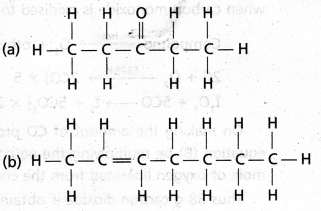
Question 5.
For each of the following compounds, write a condensed formula and also their bond – line formula.
(a) HOCH3CH2CH2CH(CH3)CH(CH3)CH3
(b)

Solution:
Condensed formula:
(a) HO(CH2)3CH(CH3)CH(CH3)2
(b) HOCH(CN)2
Bond-line formula :

Question 6.
Expand each of the following bond-line formulas to show all the atoms including carbon and hydrogen.

Solution:
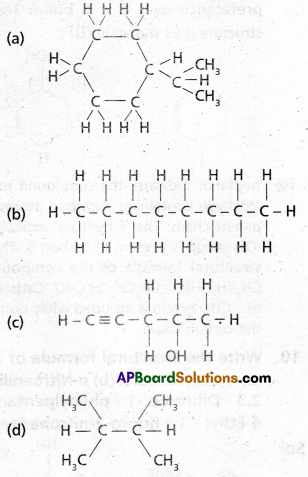
Question 7.
Structures and IUPAC names of some hydrocarbons are given below. Explain why the names given in the parentheses are incorrect.
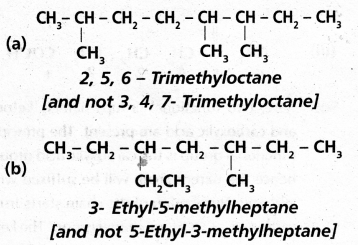
Solution:
(a) Lowest locant number, 2, 5, 6 is lower than 3, 5, 7,
(b) substituents are in equivalent position; lower number is given to the one that comes first in the name according to alphabetical order.
![]()
Question 8.
Write the IUPAC names of the compounds i-iv from their given structures.

Solution:
- The functional group present is an alcohol (OH). Hence the suffix is ‘-01’.
- The longest chain containing – OH has eight carbon atoms. Hence the corresponding saturated hydrocarbon is octane.
The – OH is on carbon atom 3. In addition, a methyl group is attached at 6th carbon. Hence, the systematic name of this compound is 6-Methyloctan-3-ol.
i)

Solution:
The functional group present is ketone (>C = 0), hence suffix ‘-one’. Presence of two keto groups is indicated by ‘di’, hence suffix becomes ‘dione’. The two keto groups are at carbons 2 and 4. The longest chain contains 6 carbon atoms, hence, parent hydrocarbon is hexane. Thus, the systematic name is Hexane – 2, 4 – dione.
ii)

Solution:
Here, two functional groups namely ketone and carboxylic acid are present. The principal functional group is the cat ooxyuc acid group; hence the parent chain will be suffixed with ‘oic’ acid. Numbering of the chain starts from carbon of – COOH functional group. The keto group in the chain at carbon 5 is indicated by ‘oxo’. The longest chain including the principal functional group has 6 carbon- atoms; hence the parent hydrocarbon is hexane. The compound is, therefore, named as 5 Oxo- hexanoic acid.
iii)
![]()
Solution:
The two C=C functional groups are present at carbon atoms 1 and 3, while the C = C functional group is present at carbon 5. These groups are indicated by suffixes ‘diene’ and ‘yne’ respectively. The longest chain containing the functional groups has 6 carbon atoms; hence the parent hydrocarbon is hexane. The name of compound, therefore, is Hexa-1, 3-dien-5-yne.
![]()
Question 9.
Derive the structure of
(i) 2-Chlorohex- ane,
(ii) Pent-4-en-2-ol,
(iii) 3- Nitro-cydohexerte,
(iv) Cyclohex-2-en-l-ol,
(v) 6-Hydroxy-heptanal.
Solution:
(i) ‘hexane’ indicates the presence of 6 carbon atoms in the chain The functional group chloro is present at carbon 2. Hence, the structure of the compound is CH3CH2CH2CH2CH(Cl)CH3.
(ii) ‘pent’ indicates that parent hydrocarbon contains 5 carbon atoms in the chain, ‘en’ and ‘ol’ correspond to the functional groups C=C and -OH at carbon atoms 4 and 2 respectively. Thus, the structure is CH2 = CHCH2CH (OH)CH3.
(iii) Six membered ring containing a carbon- carbon double bond is implied by cyclo-hexene, which is numbered as shown in (I). The prefix 3-nitro means that a nitro group is present on C-3. Thus, complete structural formula of the compound is (II). Double bond is suffixed functional group whereas -NO2 is prefixed functional group therefore double bond gets preference over -NO2 group:

(iv) ‘1 -0l’ means that a -OH group is present at C-1. OH is suffixed functional, group and gets preference over C = C bond. Thus the structure is as shown in (II) :
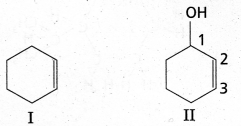
(v) ‘heptanal’ indicates the compound to be an aldehyde containing 7 carbon atoms in the parent chain. The ‘6-hydroxy’ indicates that -OH group is present at carbon 6. Thus, the structural formula of the compound is : CH3CH(OH)CH2CH2CH2CH2CHO. Carbon atom of – CHO group is included while numbering the carbon chain.
Question 10.
Write the structural formula of :
(a) o-Ethylanisole
(b)p-Nitroaniline,
(c) 2,3 – Dibromo -1 – phenylpentane,
(d) 4-Ethyl – 1 – fluoro-2-nitrobenzene.
Solution:
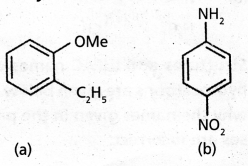

![]()
Question 11.
Using curved-arrow notation, show the formation of reactive intermediates when the following covalent bonds undergo heterolytic cleavage.
(a) CH3 – SCH3,
(b) CH3 – CN,
(c) CH3 – Cu
Solution:

Question 12.
Giving justification, categorise the fol-lowing molecules/ions as nucleophile or electrophile :
HS–, BF3, C2H5O–, (CH3)3 N :,
![]()
Solution:
Nucleophiles: HS–, C2H5O–, (CH3)3 N:, H2N– These species have unshared pair of electrons, which can be donated and shared with an electrophile.
Electrophiles: ![]()
Reactive sites have only six valence electrons; can accept electron pair from a nucleophile.
Question 13.
Identify electrophilic centre in the fol-lowing: CH3CH = O, CH3CN, CH3I.
Solution:
Among ![]() , the starred carbon atoms are electrophilic centers as they will have partial positive charge due to polarity of the bond.
, the starred carbon atoms are electrophilic centers as they will have partial positive charge due to polarity of the bond.
Question 14.
Which bond is more polar in the following pairs of molecules:
(a) H3C – H, H3C – Br
(b) H3C – NH2, H3C – OH
(c) H3C – OH, H3C – SH
Solution:
(a) C – Br, since Br is more electronegative than H, (b) C – O, (c) C – O
Question 15.
In which C – C bond of CH3CH2CH2Br, the inductive effect is expected to be the least ?
Solution:
Magnitude of inductive effect diminishes as the number of intervening bonds increases. Hence, the effect is least in the bond between . carbon-3 and hydrogen.
![]()
Question 16.
Write resonance structures of CH3COO– and show the movement of electrons by curved arrows.
Solution:
First, write the structure and put unshared pairs of valence electrons on appropriate atoms. Then draw the arrows one at a time moving the electrons to get the other structures.

Question 17.
Write resonance structures of CH2 = CH – CHO. Indicate relative stability of the contributing structures.
Solution:
[I: Most stable, more number of covalent
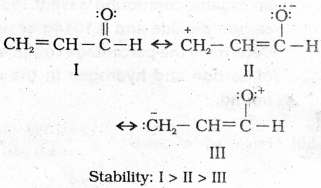
bonds, each carbon and oxygen atom has an octet and no separation of opposite charge II: negative charge on more electronegative atom and positive charge on more electropositive atom; III: does not contribute as oxygen has positive charge and carbon has negative charge, hence least stable].
Question 18.
Explain why the following two structures, I and 11 cannot be the major contributors to the real structure of CH3COOCH3.

Solution:
The two structures are less important contributors as they involve charge separation. Additionally, structure I contains a carbon atom with an incomplete octet.
![]()
Question 19.
Explain why ![]() is more stable than
is more stable than ![]() and
and ![]() is the least stable cation.
is the least stable cation.
Solution:
HyperconjugatiOn interaction in ![]() is greater than in
is greater than in ![]() as the
as the ![]() has nine C – H bonds. In
has nine C – H bonds. In ![]() , vacant p orbital is perpendicular to the plane in which C – H bonds lie; hence cannot overlap with it. Thus,
, vacant p orbital is perpendicular to the plane in which C – H bonds lie; hence cannot overlap with it. Thus, ![]() laoks hyper conjugative stability.
laoks hyper conjugative stability.
Question 20.
On complete combustion, 0.246 g of an organic compound gave 0.1989/ of carbon dioxide and 0.10149 of water. Determine the percentage composition of carbon and hydrogen in the compound.
Solution:
Percentage of carbon = \(\frac{12 \times 0.198 \times 100}{44 \times 0.246}\)
= 21 .95%
Percentage of hydrogen = \(\frac{2 \times 0.1014 \times 100}{18 \times 0.246}\)
= 4.58%
Question 21.
In Dumas’ method for estimation of nitrogen, 0.3g of an organic compound gave 5OmL of nitrogen collected at 300K temperature and 715mm pressure. Calculate the percentage composition of nitrogen in the compound. (Aqueous tension at 300K = 15 mm)
Solution:
Volume of nitrogen collected at 300K and 715mm pressure is 50 mL
Actual pressure = 715 – 15 = 700 mm
Volume of nitrogen at STP = \(\frac{273 \times 700 \times 50}{300 \times 760}\)
= 41.9 ML
22,400 ml of N2 at STP weighs = 28 g
41.9 mL of nitrogen weighs = \(\frac{28 \times 41.9}{22400}\) g
Percentage of nitrogen = \(\frac{28 \times 41.9 \times 100}{22400 \times 0.3}\)
= 17.46%
Question 22.
During estimation of nitrogen present in an organic compound by Kjeldahl’s method, the ammonia evolved from 0.5 g of the compound in Kjeldahl’s estimation of nitrogen, neutralized 10 mL of 1 M H2SO4. Find out the percentage of nitrogen in the compound?
Solution:
1 M of 10 mL H2SO4 = 1 M of 20 mL NH3 1000 mL of 1 M ammonia contains 14 g nitrogen
20 ml of 1 M ammonia contains \(\frac{14 \times 20}{1000}\) g nitrogen
Percentage of nitrogen = \(\frac{14 \times 20 \times 100}{1000 \times 0.5}\)
= 56.0%
![]()
Question 23.
In Canus method of estimation of halogen1 0.15 g of an organic compound gave 0.12 g of AgBr. Find out the percentage of bromine in the compound.
Solution:
Molar mass of AgBr = 108 + 80
= 188 g mol-1
188 g AgBr contains 80 g bromine
0.12 g AgBr contains \(\frac{80 \times 0.12}{188}\) g bromine
Percentage of bromine = \(\frac{80 \times 0.12 \times 100}{188 \times 0.15}\)
= 34.04%
Question 24.
In sulphur estimation, 0.157 g of an organic compound gave 0.4813 g of barium sulphate. What is the percentage of sulphur in the compound ?
Solution:
Molecular mass of BaSO4 = 137 + 32 + 64
= 233g
233 g BaSO4 contains 32 g sulphur
0.4813 g BaSO4 contains \(\frac{32 \times 0.4813}{233}\) g sulphur
Percentage of sulphur = \(\frac{32 \times 0.4813 \times 100}{233 \times 0.157}\)
= 42.10%
Question 25.
Write structures of different chain isomers of alkanes corresponding to the molecular formula C6H14. Also write their IUPAC names.
Solution:
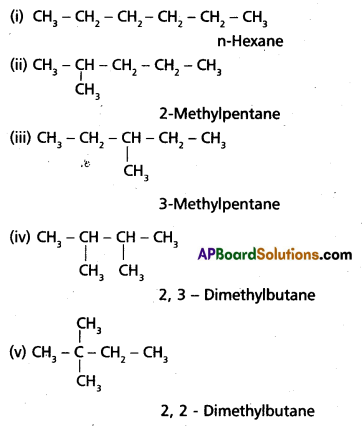
Question 26.
Write structures of different isomeric alkyl groups corresponding to the molecular formula C5H11. Write IUPAC names of alcohols obtained by attachment of -OH groups at different carbons of the chain.
Solution:
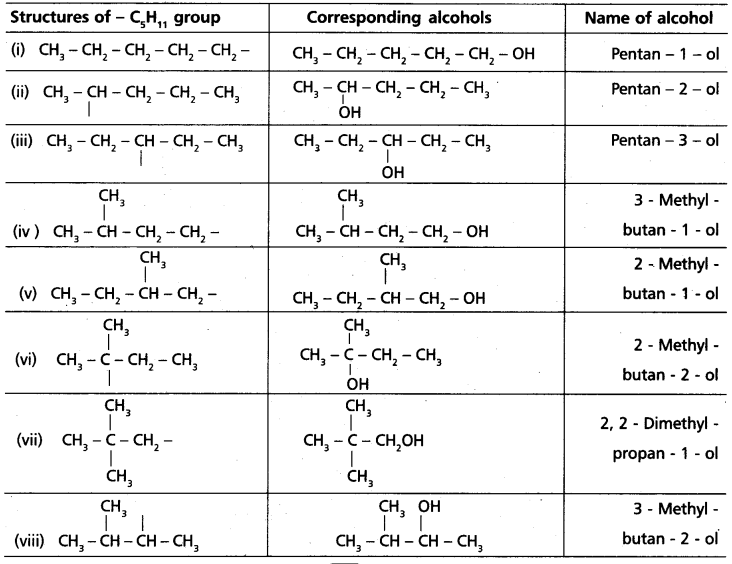
![]()
Question 27.
Write IUPAC names of the following compounds :
- (CH3)3 C CH2C(CH3)3
- (CH3)2 C(C2H5)2
- tetra – tert-butylmethane
Solution:
- 2, 2, 4, 4-Tetramethylpentane
- 3 3-Dimethylpentane
- 3, 3-Di-tert-butyl -2, 2, 4, 4 – tetramethylpentane
Question 28.
Write structural formulas of the following compounds:
(i) 3, 4, 4, 5-Tetramethylheptane
(ii) 2, 5-Dimethyhexane
Solution:

Question 29.
Write structures for each of the following compounds. Why are the given names incorrect? Write correct IUPAC names.
(i) 2-Ethylpentane
(ii) 5-Ethyl – 3-methylheptane
Solution:

Longest chain is of six carbon atoms and not that of five. Hence, correct name is 3-Methyl- hexane.

Numbering is to be started from the end which gives lower number to ethyl group. Hence, correct name is 3-ethyl-5-methyl-heptane.
Question 30.
Sodium salt of which acid will be needed for the preparation of propane? Write chemical equation for the reaction.
Solution:
Butanoic acid,

![]()
Question 31.
Write IUPAC names of the following compounds:

Solution:
(i) 2, 8 – Dimethyl – 3, 6 – decadiene;
(ii) 1, 3, 5, 7 Octatetraene;
(iii) 2 – n – Propylpent – 1 – ene;
(iv) 4 – Ethyl – 2, 6 – dimethyl – dec – 4 – ene;
Question 32.
Calculate number of sigma (σ) and pi (π) bonds in the above structures (i-iv).
Solution:
σ bonds : 33, π bonds : 2
σ bonds: 17, π bonds:4
σ bonds : 23, π bond : 1
σ bonds: 41, π bond : 1
Question 33.
Write structures and IUPAC names of different structural isomers of alkenes corresponding to C2H10.
Solution:

![]()
Question 34.
Draw cis and trans isomers of the following compounds. Also write their IUPAC names:
(i) CHCl = CHCl
(ii) C2H5CCH3 = CCH3C2H5
Solution:
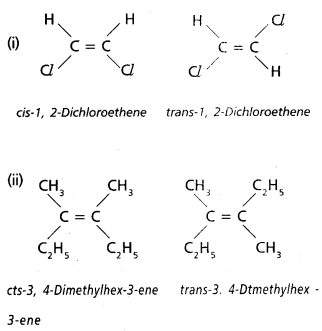
Question 35.
Which of the following compounds will show cis-trans isomerism ?
(i) (CH3)2C = CH – C2H5
(ii) CH2 = CBr2
(iii) C6H5CH = CH – CH3
(iv) CH3CH = CCl CH3
Solution:
(iii) and (iv). In structures (i) and (ii), two identical groups are attached to one of the doubly bonded carbon atom.
Question 36.
Write IUPAC names of the products obtained by addition reactions of HBr to hex- 1-ene
(i) in the absence of peroxide and
(ii) in the presence of peroxide.
Solution:

Question 37.
Write structures of different isomers corresponding to the 5th member of alkyne series. Also write IUPAC names of all the isomers. What type of isomerism is exhibited by different pairs of isomers ?
Solution:
5th member of alkyne has the molecular formula C6H10. The possible isomers are :

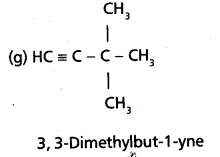
Position and chain isomerism shown by different pairs.
![]()
Question 38.
How will you convert ethanoci acid into benzene?
Solution:
